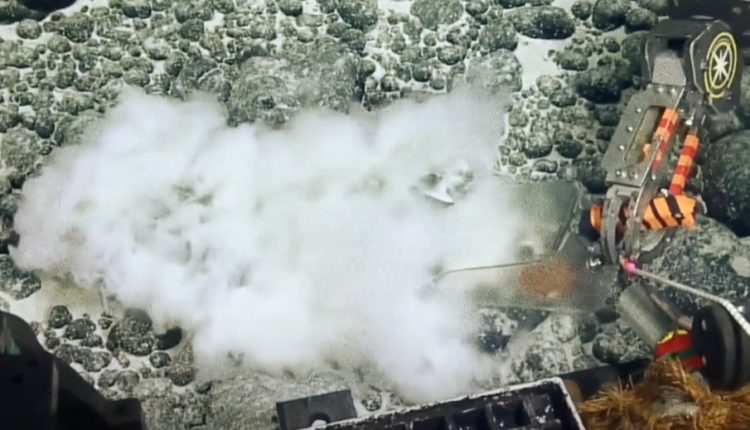Massive Megalodon Fossil Resurfaces in the Pacific’s Abyssal Realm
Researchers have made a groundbreaking discovery by finding the first in situ fossil tooth of the megatooth shark Otodus megalodon in the deep waters of the Pacific Ocean.
The study, published in Historical Biology last month, details the finding of the megalodon tooth at a depth exceeding 10,000 feet (3,090 meters) during an expedition led by the Ocean Exploration Trust (OET) aboard the Exploration Vessel (E/V) Nautilus.
The expedition, spanning three weeks, focused on exploring previously unsurveyed deep-sea habitats in the Johnston Unit of the Pacific Remote Islands Marine National Monument.
The fossil tooth, collected using a remotely operated vehicle (ROV) named Hercules, provides a rare opportunity for scientists to observe and sample a megalodon tooth in its natural environment.
Traditional methods of collecting deep-sea fossils involve dragging nets on the seafloor, making it difficult for scientists to determine the exact sampling location.
However, the in situ discovery of the megalodon tooth offers valuable contextual information, aiding scientists in understanding how these fossils formed and the factors influencing their current state. The tooth, partially encapsulated with manganese, intrigued researchers.
Nicolas Straube, Associate Professor at the University Museum Bergen in Norway and co-author of the study, highlighted the significance of the find, stating, “The fossil was discovered at a very remote deep-sea locality from which megalodon fossils are rarely documented.”
Megalodon Migration Insights

The interdisciplinary collaboration involved geologists, biologists, paleontologists, and experts from eight institutions in four countries.
The tooth, initially identified by the curatorial team at the University of Rhode Island’s Marine Geological Samples Laboratory, was later confirmed as a megalodon tooth by Dr. Dave Ebert, a leading shark expert.
Daniel Wagner, OET Chief Scientist, emphasized the importance of such collaborations, stating, “By working together, we can learn so much more about our largely unexplored ocean.”
The fossilized tooth provides insights into the distribution of megalodon, challenging the notion that it was strictly a coastal species, as the sample suggests the species migrated across ocean basins similar to modern-day species like the great white shark.
This discovery, located about 150 miles south of Johnston Atoll, showcases the value of exploring remote and uncharted deep-sea environments.
The region, teeming with biodiversity, particularly sharks and apex predators, was designated a part of the Pacific Remote Islands Marine National Monument in 2009. The findings contribute to ongoing research on the biodiversity, geological age, and volcanic history of this remote and intriguing region, shedding light on the mysteries of the deep sea.

